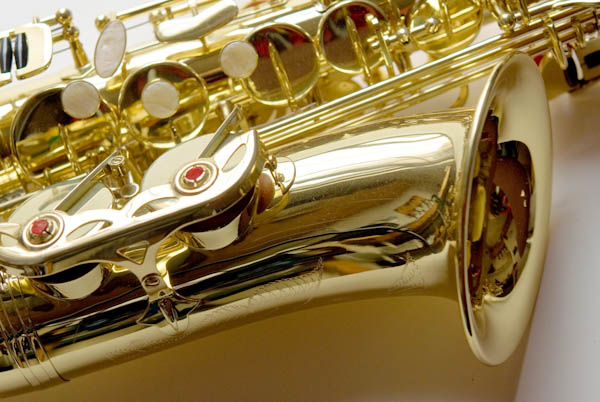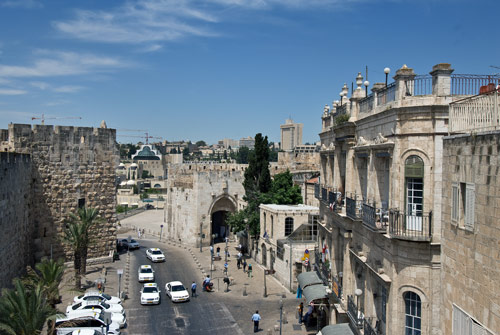The Mount Scopus Setting
A clear winter’s night in 2007 was the chilly, twinkling setting for a concert at the Brigham Young Mormon University’s Jerusalem Center for Near Eastern Studies that my husband and I attended in Israel.
Set on the hills of Mount Scopus, the Mormon Center (as it’s called for short) is a modern complex that has an exotic Moorish character. Built fairly low in height with a series of archways and decorated outdoors with desert vegetation, the appealing expanse of the religious complex compliments its Middle Eastern location. One senses that the architect was sensitive to and in tune with his exotic surroundings.
The main concert hall inside faces out onto the hills below. Complete with huge, arched glass panes, a high ceiling and an enormous organ at the back that reminds one of the Mormon love of that instrument in its American Utah roots, the setting enables members of the audience to see a large chunk of Jerusalem in the distance outside: The golden dome of the Al Aqsa mosque to the left; the maze-like quality of the walled neighborhoods of the Old City more to the center; the 21st century highway system that encircles Mount Scopus – all are visible from the listeners’ seats.
The setting can also make for strange appearances. For example, during another concert we attended in 2006, a kestral with outstretched wings flew outside through the series of archways, oblivious to the winter holiday concert sponsored by the Consulate of Italy and being taped inside to be aired on Christmas on Italian TV.
Happily, all of these concerts are ‘freebies’. Well known throughout Jerusalem with tickets posted and generally ‘sold’ out weeks in advance, the series run by season from early autumn to summer.

In Performance: Sax, Piano, and the Composer Milhaud
The performance my husband and I saw that winter’s evening was a trio featuring Yigal Meltzer on trumpet, Gan Lev on saxophone (soprano, alto, and baritone saxes, that is), and Bishara Harouni on piano.
The program started with a zippy Vivaldi piece and progressed through the centuries to Milhaud and beyond.
Before performing the Milhaud (1892-1974) piece with the pianist, Lev the saxophonist explained a bit about the composer’s background and his composition of three movements entitled ‘Scaramouche.’
First Lev noted that his teacher in Paris had himself studied with Adolfe Sax, the inventor of the instrument, and then he explained that he chose this piece in particular because both the instrument and this piece of Milhaud’s are favourites in French clubs.
The saxophonist went on to explain enthusiastically about his particular affection for the piece’s last movement named “Brazileira” because of its evocative Brazilian melodic swing which he loved to play.
Confluences of Time in Jerusalem
Most people living in Jerusalem concur that time periods often collide, converge, and meld together here. It’s not an unusual occurrence in a city that is so much at the center of major religions and political controversy.
However, certain instances are especially memorable and this concert produced one for me.
First to describe the setting somewhat more:
The audience was composed of Jews, Arabs, and Christians.
In fact, I had struck up a conversation with one of the Mormon administrators of the Center as he stood outside the concert hall doors before letting in the concertgoers like myself.
I had asked him about a beautiful photography book on Utah that lay on a table for concertgoers to look at. I asked him questions about Salt Lake City and the Mormon congregation, and he told me that the Judean Desert in Israel looks a lot like Utah in the photography book.
So I had remnants of our interesting conversation lingering in my head as I listened to Scaramouche.

Milhaud and the Helicopter
As I looked in the distance out of the huge floor-to-ceiling glass panels, I saw the gleaming, golden roof of the Al Aqsa Mosque while I listened to the sax and piano strains weaving through the air.
Suddenly, the distinct sounds of a helicopter brr, brr, brr-ing ripped the calmness of the clear, cold winter night outside the concert hall.
The wonderful performance of Milhaud’s Scaramouche was already under way. The helicopter sounded nearer and nearer.
Because my husband and I had only been in Jerusalem for a little less than five months, I became somewhat alarmed: What was the meaning of a helicopter overhead in the night? Had some violence taken place? Had some terrorist succeeded to carve a deadly piece out of the calm night? Was the helicopter taking the injured to hospitals? My mind quickly darted to various possibilities.
But I listened on, as we all did. The playing was enchanting, delightful, disarming.
The Brazileira movement in particular made you want to jump out of your seat, forget political realities and fears, erase those helicopter sounds from your consciousness, and dance with abandonment.
A Republican Secretary of State in Jerusalem
As we all clapped with tremendous appreciation at the end of the piece and one could hear shouts of ‘bravo!’ floating through the concert hall, the woman next to me with whom I had spoken Hebrew before the concert turned to me and said this time in English something like, “Condoleezza Rice – I’m sure it was [Secretary of State] Condoleezza Rice whom that helicopter was following. Did you hear it during the performance? I think it was she because I was stuck in traffic getting here because of her. Same direction, same road.”
“What did you say?” I replied in Hebrew to the woman because I could not at first understand her English completely. She repeated the comment in Hebrew and I understood what had been occurring in the skies when the next piece began.
I sat back and thought about Rice and her entourage on the highway, the patroling helicopter in the sky, the mosque to the left, the synagogues in the Old City maze, the audience surrounding me, the counterpoint of the carefree music – and I knew once again that I was in Israel, and that this mishmash of Jerusalem is its reality, its strength, and its downfall all rolled into one.
Our Well-Informed Taxi Driver
Getting back to our apartment in central Jerusalem was difficult from Mount Scopus. We took a combination of taxi and bus. By coincidence, our taxi driver that evening was someone who had picked us up twice before when we attended concerts at the Mormon Center. We remembered him, and then he remembered us.
A very cordial and talkative man, the taxi driver spoke in Arabic through his mike to his employer to get further directions about whom he was to pick up after dropping us off at our apartment.
When he stopped talking in Arabic, we started talking with him in Hebrew and English about the performance. Then I mentioned the helicopter and asked him if he knew about it and if it had in fact been security for the then Republican Secretary of State of the Bush Administration, namely Condolezza Rice.
“Oh, yes, it was for her, I am certain. She left Jerusalem tonight. She was in Ramalla, she met with Abu Mazer there. She went to Jericho and tonight into Jordan,” he said very pleasantly.
Pondering about Peace
“Do you know how long it takes to get from Jericho to Jordan?” I continued, now back to speaking in Hebrew.
“About five minutes, that’s all,” he replied.
“Do you think there is a chance for peace soon?” my husband and I asked a little bit later in the ride, as the conversation swayed back into English.
“Not in our time, I don’t believe,” he responded slowly and sadly in his broken English.
Arab to Jew, Jew to Arab
Arab to Jew, Jew to Arab — we sat there and talked in the taxi, enjoying the clearness of the night and the relative stillness of the highway.
As he drove on, we asked him about his life as a taxi driver. He told us about the twelve-hour days he works, about his wife and kids, and how he wants to go for further education but he has no time for it.
We asked if his passengers were nice overall, and he told us it varied but that often people who were stressed for time in the city blamed him for things over which he had no power on the road.
We commiserated with him, and he smiled wanly.
Milhaud in the Scope of Israel’s Modern Times
As he dropped us off in Zion Square in the center of Jerusalem so we could catch the bus home for the final leg of our journey, I became aware again of the confusing reality of modern-day Jerusalem and Israel: How full it is of conflicting pain and pleasure, of apprehensive fear and freeing delight.
And I realized once again that like that superb performance Milhaud’s ‘Brazileira’ movement in his ‘Scaramouche’ composition that I had heard that evening, living in Israel works best if one can somehow feel the overall tune and respond in kind at a moment’s notice.
A view towards Jaffa Gate from within the Old City, Jerusalem
